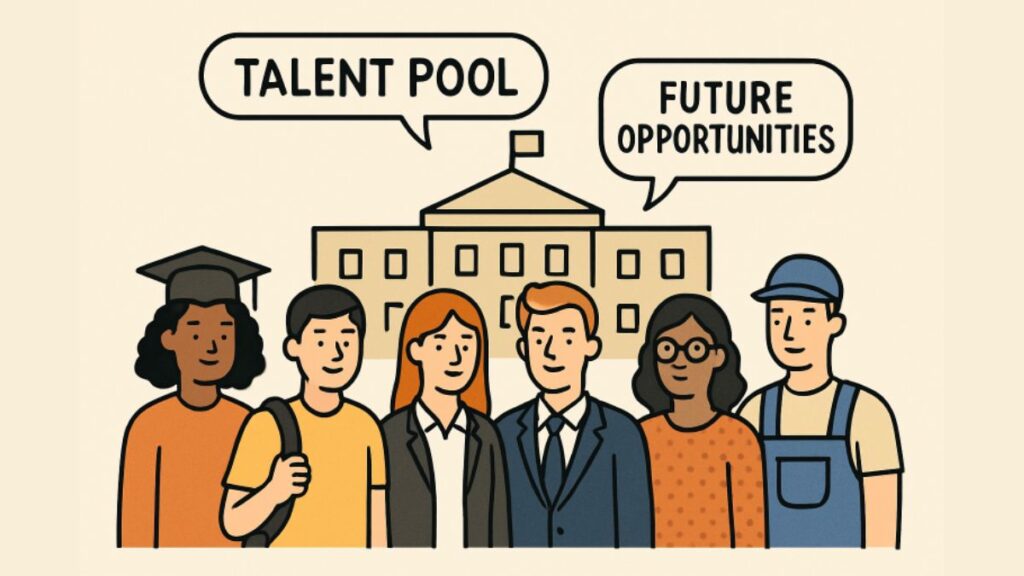Introduction
In today’s rapidly evolving job market, organizations with robust strategies for attracting and retaining top talent thrive. Building a resilient workforce isn’t just about filling immediate vacancies—it’s about being ready for the shifting demands of technological change, globalization, and evolving industry trends. Talent pooling is foundational in this process, allowing companies to curate groups of qualified candidates ready to address future needs efficiently and strategically. Developing a talent pool is not a simple, short-term tactic; rather, it is an ongoing investment that can define the future success of any organization, especially those in highly competitive sectors where top talent is scarce.
Employers who invest in talent pooling reduce time-to-hire and recruitment costs and gain access to a broader and more diverse candidate pipeline. Hiring managers can respond quickly to new opportunities or unexpected staff turnover by building a bench of pre-assessed, engaged candidates. As competition for skilled professionals heats up and the demand for niche expertise rises, leveraging creative, forward-thinking strategies has never been more essential. These approaches fill current roles and ensure the organization adapts and thrives in an unpredictable landscape, ultimately creating a workforce positioned for sustained, long-term success.
Unconventional Recruiting Methods
Moving beyond traditional hiring methods can reveal top candidates who may otherwise remain unnoticed by standard application processes. Initiatives such as apprenticeships, job shadowing, and upskilling programs allow companies to discover and mold talent from within and outside the organization. Apprenticeships, in particular, help close skills gaps by providing real-world experience and personalized learning paths, ultimately increasing loyalty and employee retention. On the other hand, job shadowing gives potential candidates a firsthand look at day-to-day responsibilities, building familiarity and confidence on both sides. Additionally, companies are tapping into hackathons, virtual job fairs, and project-based recruitment to spot high-potential individuals with non-linear career trajectories and unconventional backgrounds. These strategies help organizations connect with problem solvers, creative thinkers, and adaptable professionals who might not fit the mold of a traditional candidate but have the drive to excel once given a chance.
Leveraging Technology and Data Analytics
Technology is fundamentally transforming how organizations identify, engage, and hire talent. Modern Applicant Tracking Systems (ATS) centralize recruitment data, streamline workflow, and improve candidate communication, reducing the administrative burden and enhancing candidate experience. AI-driven matching tools further refine the process, analyzing resumes, predicting cultural fit, and proactively surfacing best-in-class candidates based on qualifications and behavioral and soft skills assessments. HR professionals can make smarter, evidence-based decisions by applying data analytics to assess recruitment campaigns, hiring outcomes, and candidate sources. This leads to a more targeted and strategic approach to building talent pools. According to SHRM, analytics and AI are revolutionizing how companies compete for talent by enabling real-time tracking of key recruitment metrics and predicting future hiring needs.
Fostering Internal Mobility
Retaining top performers is just as critical as finding new ones. Internal mobility programs enable staff to explore opportunities across different departments and roles, strengthening organizational knowledge and maintaining employee engagement. This empowers and keeps employees engaged, significantly reducing hiring costs and the risks associated with onboarding external talent. Organizations benefit from employees’ existing company knowledge, which accelerates onboarding, minimizes cultural adjustments, and fosters loyalty. By offering transparent career paths, cross-functional training, and mentorship, organizations keep high-potential talent within their ecosystem. Internal mobility also helps prepare teams for future leadership, filling succession pipelines with proven, trusted talent.
Employee Referral Programs
Employee referrals are among the most effective ways to expand a talent pool. Existing staff can identify and vouch for candidates who fit the culture and have the skills necessary for success. Referral hires have statistically higher retention rates and stronger job satisfaction, and they tend to ramp up faster due to their connection within the company. A well-structured referral program with enticing incentives and streamlined processes motivates employees to regularly recommend strong candidates, fueling the talent pool from a trusted, internal source. Regularly refreshing referral policies and celebrating successful hires can keep the momentum alive and ensure consistent contributions to the talent pipeline.
Engaging with Educational Institutions
Creating partnerships with colleges, universities, and trade schools opens doors to emerging talent and allows organizations to cultivate new professionals early in their careers. Internship programs, co-op placements, and guest lectures provide students with practical experience and brand exposure, while companies develop early relationships with high-potential candidates. Engaging with these institutions gives companies access to the latest academic research and technological advancements. These relationships can lead to a steady flow of new graduates eager to grow within the organization, easing workforce planning for the future and ensuring organizations keep pace with changing industry needs.
Diversifying Talent Sourcing Channels
Avoiding overreliance on conventional job boards broadens the reach of talent searches and unlocks new communities of skilled professionals. Platforms like LinkedIn, GitHub, and industry-specific forums provide access to passive candidates who may not be actively job hunting but would consider the right opportunity. Leveraging alumni networks, attending professional association events, and running targeted social media campaigns can help uncover candidates from diverse backgrounds and experiences. This approach expands the talent pool and supports organizational diversity and inclusion goals, contributing to better team innovation and business performance as outlined by Harvard Business Review.
Building a Strong Employer Brand
An organization’s reputation as an employer is decisive in attracting top-tier talent. Businesses can differentiate themselves in a competitive market by sharing authentic stories through employee testimonials, social media spotlights, and showcasing company achievements. A strong employer brand conveys values, work culture, growth opportunities, and the organization’s commitment to diversity, making the company attractive to active and passive job seekers. Companies that articulate purpose, show commitment to employee well-being, and provide clear advancement opportunities are more likely to be seen as employers of choice, which leads to an influx of high-caliber talent interested in joining their teams.
Continuous Learning and Development
Organizations championing ongoing skill development and professional growth foster stronger, more adaptable talent pools. Investing in training initiatives, career advancement resources, and mentorship programs helps employees keep pace with changing industry needs and technological advancements. Proactive learning environments also attract curious, ambitious candidates who value companies committed to personal and professional improvement. Access to courses, certifications, and skill-building workshops prepares staff for broader roles, increases engagement, and ultimately future-proofs hiring strategies. This continuous learning philosophy ensures that teams remain competitive, relevant, and able to meet future challenges.






